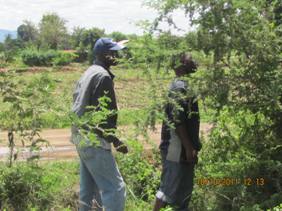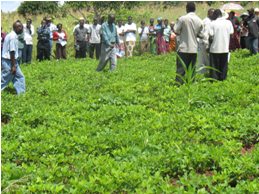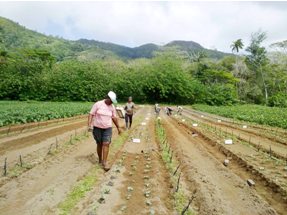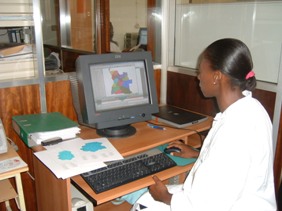 The mandate of this Centre is to develop and maintain, the SADC Plant Genetic Resources Centre (SPGRC) in Lusaka, Zambia and a network of National Plant Genetic Resources Centres (NPGRCs) in all the SADC Member States and train staff to ensure that an adequate number of SADC nationals are trained in plant genetic resources management in order to collect, conserve, document and guarantee the safe preservation, first of all, the indigenous plant genetic resources of natural and crop heritage of the region.
The mandate of this Centre is to develop and maintain, the SADC Plant Genetic Resources Centre (SPGRC) in Lusaka, Zambia and a network of National Plant Genetic Resources Centres (NPGRCs) in all the SADC Member States and train staff to ensure that an adequate number of SADC nationals are trained in plant genetic resources management in order to collect, conserve, document and guarantee the safe preservation, first of all, the indigenous plant genetic resources of natural and crop heritage of the region.The main activities of the Centre include to:
- maintain the SPGRC base collection for the SADC Member States at Chalimbana Research Station;
- develop and maintain the SPGRC Documentation and Information System (SDIS) to ensure the smooth running of the system at all NPGRCs;
- publish an annual report and a biannual SPGRC Network Newsletter;
- promote the establishment of field genebanks and in situ/on-farm conservation in the Member States;
- provide technical backstopping to NPGRCs on germplasm collection, multiplication, regeneration, characterisation and documentation;
- train staff at different levels;
- compile and publish various documents arising out of the Regional Crop Working Groups (RCWGs) activities.

SPGRC having been established through a 20-year Nordic-funded project that commenced in 1989, enormously benefitted from the support that ended in 2010 time after which SPGRC has mainly operated on funds provided by the SADC Member States. However, SPGRC has continued and strengthened relations with Bioversity International, FAO and the Global Crop Diversity Trust (GCDT) who have in different magnitudes supported it in building capacity in conservation and utilization of plant genetic resources. Likewise, CGIAR and other IARCs (like AVRDC) with strong SADC or African programmes on crops that also form important components of SPGRC’s collections and work have remained essential to work with in making the current and future accessions of SPGRC and the NPGRCs useful to the region. The NEPAD Southern African Network for Biosciences (SANBio) whose designated Regional Node for Plant Genetic Resources is at SPGRC has contributed in strengthening capacity in conservation and sustainable utilization of plant genetic resources through funding some activities and is expected to support it further in the next phase(s) of the programme.
Activities
Training and Education
The SPGRC has contributed significantly to human resources development in SADC. By the end of 2004 a total of 227 and 55 SADC nationals have undergone short hands-on courses and MSc degree training, respectively. Currently, there are 2 SADC nationals pursuing PhD studies in plant genetic resources sciences in Sweden.

Representative seed samples of populations of indigenous plant species are collected throughout the SADC region. Collection expeditions also target populations of introduced species that have been in the region long enough to have developed unique adaptive features. High priority is accorded to materials under immediate threat. Collection plans are developed regionally but the actual collection is done by the NPGRC in each country. Until March 2008, there were 13,424 original samples stored in the base collection at SPGRC, deposited by NPGRCs. In the region through NPGRC, there are about 44,000 accessions held by national centres.
SPGRC publishes annual reports, mandate species lists, workshop proceedings and bi-annual newsletters. It also publishes promotional materials that include brochures and flyers, Christmas/greetings cards, calendars, etc. In order to enhance the institutional public visibility, SPGRC engages itself in producing radio and television programmes when and where appropriate. It also participates in regional and national agricultural shows and fairs.
Material
Ex situ Seed Conservation
On-farm Conservation


Characterisation and Evaluation
Documentation and Information
 The large number of accessions collected and the accompanying data for each and every accession makes it imperative to have a reliable documentation system. SPGRC has developed the SPGRC Documentation and Information System (SDIS) and
The large number of accessions collected and the accompanying data for each and every accession makes it imperative to have a reliable documentation system. SPGRC has developed the SPGRC Documentation and Information System (SDIS) and  installed this on computers at all the NPGRCs. This standardisation of data recording and keeping among the 15 NPGRCs and SPGRC enhances use and exchange of information.
installed this on computers at all the NPGRCs. This standardisation of data recording and keeping among the 15 NPGRCs and SPGRC enhances use and exchange of information.SPGRC is also extensively engaged in enhancing its public visibility to which pursuance participates in fairs and shows, broadcasts programmes in radio and television. It has also publuished various promotional materials that include brochures, flyers, newsletters, annual reports, outputs from crop working groups, etc.
Organisation
Members of the Board of SPGRC
|
Dr Pedro Mocambique |
Angola |
|
Dr Tiny Motlhaodi |
Botswana |
|
Prof Kankolongo Mbuya |
Democratic Republic of Congo |
|
Dr Innocentia S. Kunene |
Eswatini |
|
Dr Lefulesele Lebesa |
Lesotho (Chair) |
|
Dr Jacqueline Rakotoarisoa |
Madagascar |
|
Dr Wilkson Makumba |
Malawi |
|
Ms Carla do Vale |
Mozambique |
|
Mr. Yacoob Mungroo |
Mauritius |
|
Ms Fransiska Andowa |
Namibia |
|
Ms Linetta Eftico |
Seychelles |
|
Mrs Noluthando Netnou-Nkoana |
South Africa |
|
Dr. Geoffrey S. Mkamilo |
Tanzania |
|
Mr Godfrey P. Mwila |
Zambia (Vice Chair) |
| Dr Cames Mguni |
Zimbabwe |
|
Ex-officio Members |
|
|
Mr Domingos Gove |
SADC (Director of FANR) |
| - | Donor Representative |
|
Mr Justify Shava |
SPGRC (Secretary) |
|
|
|
SPGRC Staff Members
| Mr Justify Shava |
Head, SPGRC (04 July 2017) |
| Ms Thandie J Lupupa | Senior Programme Manager In-Situ Conservation (16 May 2006) |
| Mr Barnabas W Kapange | Senior Programme Manager - Documentation & Information (09 May 2006) |
| Ms Sthembiso A. Mbhele |
Senior Programme Manager Ex-Situ Conservation (02 July 2019) |
| Mrs Mary B Phiri | Assistant Administrative Officer (1 March 2000) |
| Ms Florence C Chitulangoma | Assistant Finance Officer (8 March 1993) |
| Mrs Peggy S Ng'ono | Technical Officer-Conservation (1 June 2005) |
| Mr Mike Daka | Technical Officer-Documentation & Information (21 May 2012) |
| Mr Ferdinand Mushinge | Technical Officer In situ (1 March 2004) |
| Mrs Phyllis M Litula | Personal Secretary (12 November 2001) |
| Mr Wilbroad M Chashi | Senior Finance Clerk (1 July 2002) |
| Mr Julius Daka |
Driver (2017) |
| Mr Kapelwa E Songa | Typist/Receptionist (1 September 1989) |
| Mr Gibson Zulu | General Worker (1 August 1989) |
| Mr John Mfwembe | Worker (4 September 1989) |
| Mr Stephen Siakanchele |
General Worker (2017) |
| Mr Olipen Phiri | General Worker (5 January 2009) |
Contacts for SPGRC Senior Staff:
| Name | Position | Telephone (Mob.) | |
| Justify Shava |
Head of Institution | +260 964431195 |
This email address is being protected from spambots. You need JavaScript enabled to view it.; This email address is being protected from spambots. You need JavaScript enabled to view it. |
| Barnabas W. Kapange | Senior Programme Officer - Documentation & Information | +260 979 365122 | This email address is being protected from spambots. You need JavaScript enabled to view it. |
| Thandie J. Lupupa | Senior Programme Officer - In-Situ Conservation | +260 976 551293 | This email address is being protected from spambots. You need JavaScript enabled to view it. |
| Sthembiso A. Mbhele |
Senior Programme Officer - Ex-Situ Conservation | +260 764 922588 |
This email address is being protected from spambots. You need JavaScript enabled to view it.; This email address is being protected from spambots. You need JavaScript enabled to view it. |
Terms of Reference of the Regional Crop Working Groups
The composition:
- Five scientists from the SADC Member States who are specialists in their mandate species;
- Researchers from the SADC Regional Programmes, Projects and scientists from IARCs as required;
- Staff of SPGRC will provide the secretariat; and
- NGB scientists will provide the technical backstopping.
The RCWGs will make recommendations to the Director of SPGRC on:
- Strategies;
- Priorities for plant species to be collected and conserved ex situ;
- Priorities for plant species and areas for in situ conservation;
- Guidelines for acceptance of material for inclusion in the collections;
- Standards for seed quality and quantity of samples to be stored in the collection;
- Methods and techniques for regeneration and multiplication of accessions in order to ensure genetic integrity; and
- Any other issues relevant to conservation and utilization of the species presented to the RCWGs by SPGRC or the Board.
- The Regional Crop Working Groups will meet at least once a year.
The National Plant Genetic Resources Committee (NPGRCom)
The National Plant Genetic Resources Committee for each country will have the following mandate:
- Coordination and provision of policy guidance on national conservation and use of Genetic Resources for Food and Agriculture (PGRFA);
- Facilitation and fostering strategic partnerships and mobilizing funds from National, Regional and International Cooperating Partners to support the conservation and use of genetic resources;
- Development and serving as a forum for coordination and implementation of a national plant conservation programme, consisting of public education and outreach, research, conservation and restoration actions, traditional plant materials development coordination including local seed collection, database coordination and information exchange,;
- Programme monitoring and evaluation of NPGRC activities and may periodically and where necessary, review Terms of References of the NPGRCom members;
- The NPGRCom shall elect a chairperson from among its members for a one year term with eligibility for re-election. Chairperson of the NPGRCom shall represent the country at the annual and other SPGRC Board meetings;
- The NPGRCom shall hold at least one regular meeting in a year. The time and place of the meeting shall be communicated to Members at least a month before;
- A member department (agriculture-related) may designate one official (with an Alternate) to serve as its representative to the Committee, who will attend scheduled meetings. Each member department will inform the Committee, in writing, of the name and position of its representative and alternate, or of any changes of same;
- Representatives of the SADC Executive Secretary (Director of FANR) and donor community, and the NPGRC Curator (acting as Committee Secretary), shall be ex-officio members of the Committee, with no voting privileges;
- Constitute National Working Groups which will report regularly to the Committee may be formed or disbanded as needed, at the discretion of the Committee, consistent with the applicable requirements for conservation of PGRFA; and
- The NPGRCom may appoint a Sub-Committee for any of the purposes of the Committee which in its opinion would be better regulated or managed by means of a Sub-Committee, and may delegate any of its functions to a Sub-Committee or to any officer or servant of the Committee, as it thinks fit.

